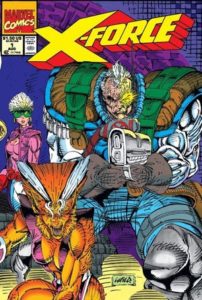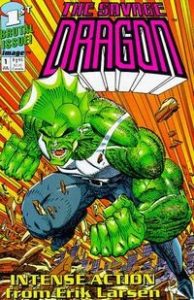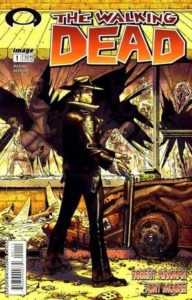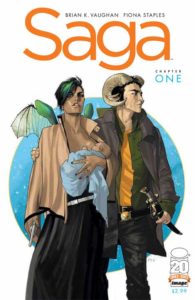Ask anyone to name a comic publisher and they will most likely mention Marvel Comics or DC Comics – and it’s no surprise, with both producing movies, television series, merchandise and comics that are incredibly popular.
But behind all of that success are the individual creators. People that write, illustrate, edit and produce the comics on which these vast entertainment empires are built.
For a long time those people were not recognized. In the 1990s, a group of creators set out to change that, hoping to revolutionize the industry by ensuring creators retained the rights to their own work. They founded Image Comics, which would go on to not only change the ways in which comics were published, but also grow to become the third largest graphic novel and comic book publisher in the United States.
Leaving Marvel & DC

In the early 1990s, there were very few avenues for comic and graphic novel creators, writers and illustrators to own their own content. The prevailing work-for-hire model gave publishers most of the rights, and thus money, associated with any content produced by their employees. Marvel Comics and DC Comics lead the market utilizing this strategy, not only benefiting greatly from the creative output of their employees, but offering them little in return in regards to royalties or increased pay, despite producing merchandise and other revenue streams directly using their work. Realizing the need for shifting to creator-owned publishing, a group of Marvel and DC creators took matters into their own hands.
Over dinner in 1991, Erik Larsen, Rob Liefeld and Jim Valentino approached Malibu Comics about possibly joining the publisher. All three were involved with high-profile superhero comics at Marvel, with Larsen working on The Amazing Spider-Man, Liefeld creating X-Force, and Valentino rebooting Guardians of the Galaxy. At the time, Malibu Comics was one of the few creator-ownership driven publishers, and, while small, offered the perfect opportunity for these creators to leave Marvel and DC behind.

In late 1991, the group made their move, adding Todd McFarlane (who wrote and illustrated Spider-Man) and Jim Lee (X-Men), letting Marvel and DC know they would be leaving to develop their own publishing company and expressing their reasoning behind the move. The group moved quickly, adding Marc Silvestri and Whilce Portacio (both known for their involvement in various X-Men projects at Marvel).
These seven creators formally founded Image Comics in 1992. Their departure instantly made ripples, not only being dubbed the “X-odus” (a portmanteau referencing the fact many leaving were involved in X-Men projects), but also directly affecting Marvel’s stock price.
Growing Pains
Image Comics set out to be the needed shift within the industry from publisher-owned to creator-owned output. They wanted Image to operate as a publisher in which creators could publish their own material without giving up copyrights to their intellectual property. In fact, this became one of two core tenets to how Image would operate: one, creators would own all of their work, not Image; and two, Image partners could not interfere with the choices (both financial and creative) of those made by other Image partners.
The second provision alludes to the structure of Image Comics, as each of the founding partners was to have his own imprint, or studio. The idea was that each partner would have their own imprint, in which they oversaw and controlled all decisions, but would still be published under the umbrella of Image Comics. Initially there were six studios (as Portacio was occupied with family matters at the time): Larsen’s Highbrow Entertainment, Lee’s WildStorm Productions, Liefeld’s Extreme Studios, McFarlane’s Todd McFarlane Productions, Silvestri’s Top Cow Productions, and Valentino’s Shadowline.
Each studio immediately began producing work, with Malibu covering all of their administrative needs. Image’s initial releases were all highly successful, and included notable titles that would continue to be staples of the publisher, like Larsen’s The Savage Dragon and McFarlane’s Spawn. Within two years Image had become successful enough to leave Malibu behind, hiring Larry Marder, an independent cartoonist, to oversee all of the day-to-day needs of the company.

Given the unilateral control of the partners, some began to explore publishing works by independent creators, extending to them the same benefits of creative control and rights ownership. At the time, this was a very unusual practice, as publishers often did not work directly with freelance and independent creators. Image was looking for ways to diversify its offerings, expanding beyond projects the partners were directly involved in. While the initial forays using this approach did not end up being fruitful, Image would continue this practice for the coming decades. This portion of Image’s publishing practice eventually shifted to its own imprint, Image Central.
The early years were not without strife, though, as tensions came to a head. In 1996, Silvestri ended his partnership, taking Top Cow with him, as he felt that Liefeld was poaching his artists for his own imprint. This accusation resulted in Liefeld resigning, giving up his stake in Image.
After his departure, Silvestri, and Top Cow, returned to Image. This was unfortunately not the only partner change, as Jim Lee sold his studio, WildStorm, to DC in 1999. The following years were somewhat fallow for Image, as they faced fierce competition from other small publishers, like Dark Horse Comics, and failed to produce new successful series.
Image: 2009 to Now

After the slump of the early 2000s, Image recommitted to its roots. In 2008, Image made long-time collaborator Robert Kirkman (famous for co-creating The Walking Dead and Invincible) a partner—the first non-founding partner. The following year they also named Eric Stephenson, who had previously edited numerous Image series, as well as worked in other administrative roles, to Publisher. This proved a fateful decision, as he immediately shifted the scope of Image’s publishing, returning to the idea of publishing more works that diversified their offerings through partnerships with independent creators, sparking a period of great success and critical acclaim. In fact, Image was on a bit of a hot streak in the early 2010s, with several award-winning series, like Chew, Fatale, The Manhattan Projects, Morning Glories, and Saga.

These titles, all firmly outside of the traditional superhero fare that made Image’s founders famous, went on to receive numerous awards and cement Image’s standing as an innovative and important comics publisher. Currently there are five major imprints at Image: three original imprints, Todd McFarlane Productions, Top Cow Productions, and Shadowline Comics; as well as two new imprints, Image Central (for publishing independent creators’ work) and Skybound Entertainment (Robert Kirkman’s imprint, founded in 2010). While not formally dissolved, Highbrow Entertainment has shifted to only producing The Savage Dragon series, and its numerous spin-offs, as Larsen has changed his focus.
Image Comics has built a legacy of high-quality creator-owned content, and shows no signs of stopping. Series and titles published by Image have won just about every award out there, including Hugo Awards (for science-fiction and fantasy works), Russ Manning Awards (A Sand Diego Comic-Con award recognizing early-career artists), The Edgar Awards (for mystery works), Bram Stoker Awards (horror and dark fantasy works), Young Adult Library Association’s Great Graphic Novels for Teens, and the prestigious Eisner Award (industry-voted awards for American comics). In fact, Image’s Marjorie Liu was the first female to win the Eisner for Best Writer. Works published by Image have been best-sellers, turned into numerous television shows and movies, and have entered the broader public consciousness. In many ways, Image Comics revolutionized the industry – all while proving you could respect creators along the way.

